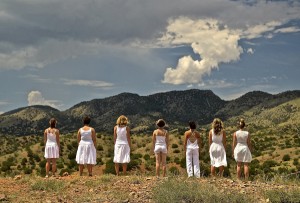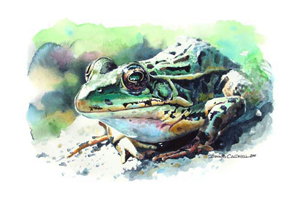A Creek’s Heart, Expressed Through Art
Imagine kneeling at a rare brook in the desert. Gazing upon the vista from a mountaintop at a hushed valley below. Remarking on the sensations felt, images seen, sounds traveling across your ears and the scents and signs of the seasons, what does your heart tell you? How would you convey that connection?

A scene from “Rosemont Ours,” a dance film celebrating the species that would be impacted by a Canadian company currently seeking approval to mine in the Santa Rita Mountains.
Photo courtesy of Ben Johnson & NEW ARTiculations Dance Theatre
Join Tucson’s arts community and Cienega Watershed Partnership (CWP) on Saturday, Feb. 8, in spreading awareness about the Cienega watershed – a region bounded by the Canelo Hills on the southern end, the Whetstone Mountains on the eastern flank, the Santa Ritas Mountains to the west, and the Rincon Mountains to the north. Cienega Creek flows northwesterly, year-round, from the Sonoita Plain to Tucson’s southeastern edge where it becomes Pantano Wash. Artwork of, about and inspired by the watershed contains a valuable message: as one of the last perennial streams in the region, Cienega Creek has inherent importance to Tucson. The watershed also contributes significantly to the recharge of Tucson’s aquifer.
Cienega is Spanish for “wetlands;” imagine a cool, lush miracle in the desert. Really! Already vulnerable due to recent drought, it is now additionally threatened by Rosemont Copper’s proposed open-pit mine. CWP is a collaborative network actively engaged in sustaining the unique natural and cultural heritage of the Cienega watershed. To ensure the future of the creek, CWP coordinates programs for Youth Engaged Stewardship (YES!), frog conservation, erosion restoration, water monitoring, climate change scenario planning, and oral history. CWP works with every stakeholder; ranchers, recreational users and government agencies all impact the sustainability of ecosystems (including human).
Artists bring a unique focus to the richness and fragility of the Cienega watershed including Davidson Canyon, the Santa Ritas and Sonoita-area grasslands. The CWP Annual Reception will feature visual interpretations of the watershed through the arts. Many of the artists double as watershed managers and scientists. Others were introduced to the watershed on poetic and plein-air field-visits just last year.
A screening of “Rosemont Ours,” a short film by NEW ARTiculations Dance Theatre and visual artist Ben Johnson, and directed by Kimi Eisele, will show dancers doing movement meditations within the watershed. Eisele explains that by embodying the flora and fauna, “We realize how much we share with them, and how it changes us to try to see the world from their perspective.”
Prose will also be presented at the reception. Tucsonan and geographer Eric Magrane led the poetic research field trips. During these trips groups wrote individually and collaboratively, exploring relationships with the landscape and its inhabitants. “Poetry helps me to think otherwise about landscape,” Magrane explains. “A poem is about bringing life. It’s about relationship. It’s about witness.”
Watercolors shown will include works by Dennis Caldwell of Caldwell Design and Meredith Milstead of The Drawing Studio.
“During the past 6 months I visited the Santa Ritas and environs numerous times to sketch and paint outdoors,” says fellow local plein-air painter Betina Fink. “Experiencing the land while painting and drawing helped me to honor it, and pay homage to a region that could possibly be destroyed.” Caldwell has worked to protect endangered species of the creek, and of Empire Valley at its northern end, since the late 1990s. He has developed an intimate understanding of the ecology of the area, working on a CWP grant (The F.R.O.G. Project) to restore Chiricahua leopard frogs in the watershed.
Civano Middle School students, led by teacher Markus Whitaker, have also chipped in. They donated artworks focusing on healthy human relationships with the natural environment in Las Cienegas National Conservation Area, on the southern end of the watershed.
Select pieces from photography exhibit “Lens on the Land” will be on display. This project, led by Josh Schachter and Brian Powell, exquisitely shows the cultural and ecological richness of the watershed as captured by photographers from throughout the Southwest. “Lens on the Land” is supported by CWP partner organizations The Sonoran Institute and Save the Scenic Santa Ritas. (See story here.)
Take a moment to ponder the precious resources to Tucson’s early dwellers: flowing water, riparian cottonwood trees, topminnows… Imagine grasslands with antelope grazing, surrounded by pristine saguaro-studded slopes. You can still experience this today in the Cienega watershed! CWP is us: residents, agencies and scientists working together to sustain this heritage a hundred years into the future.
Cienega Watershed Partnership’s Annual Reception takes place Saturday, Feb. 8 at 1 p.m. at Civano Neighborhood Center, 10501 E. Seven Generations Way. Admission to the exhibit and silent auction is free. Look forward to local libations from Dragoon Brewing Company and Wilhelm Family Vineyards, and bring cash to vote in the infamous chili cook-off. Live traditional Irish folk music will be provided courtesy of Púca. Performances and annual Watershed Wall of Honor Awards begin at 1:30 p.m. Learn more at Cienega.org.
CWP Board Member Mead Mier guided many of the artistic field-visits. Mier has over a decade’s experience in watershed restoration issues including monitoring the hydrology of the Cienega Creek.







Also find us on...